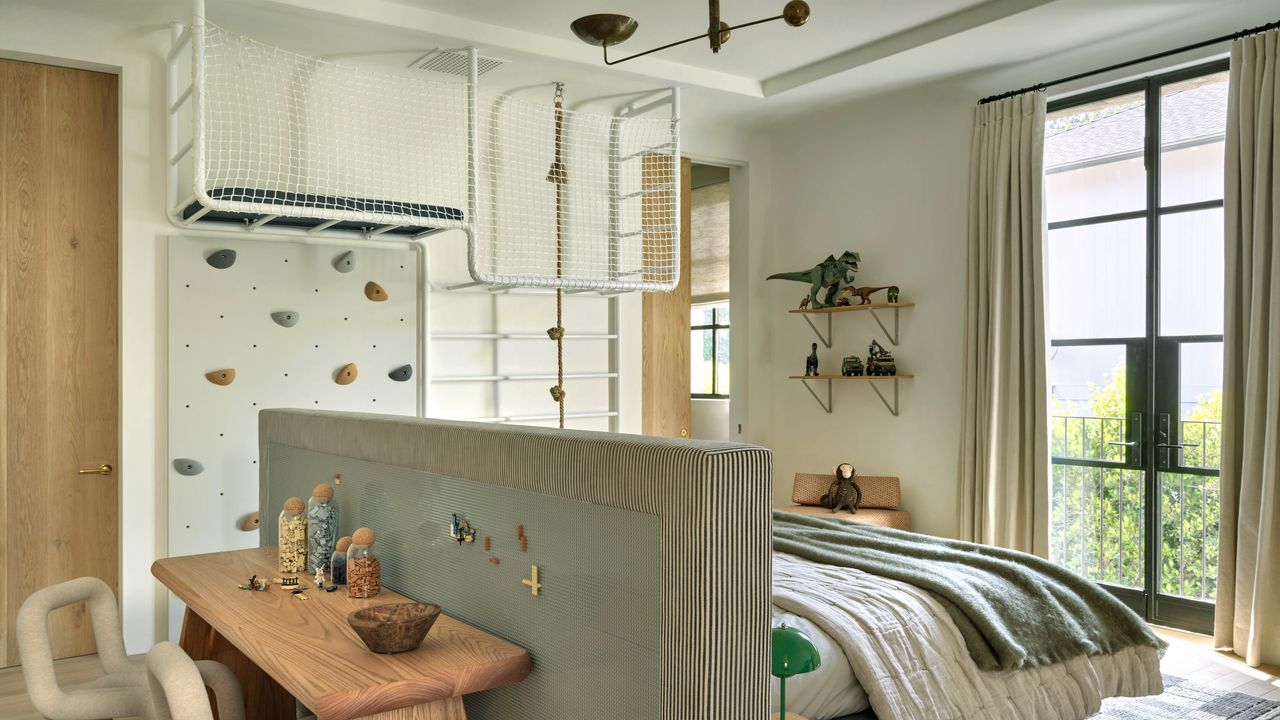
Even in the most design-conscious homes, children’s bedrooms are often where the unsightliest items go to hide. That is, until you learn how to style a kid’s room. This will help you avoid the primary-colored plastic, the cartoon decals, and mountains of glittery-eyed stuffed animals, all conveniently contained behind a closed door.
Of course, kids spaces aren’t, and shouldn’t be, entirely about what looks and feels good to grown-ups. In the best cases, a child’s bedroom is a space that can flex: It accommodates kids as they grow. It shifts as needs and interests change. And it can function as both a colorful, kid-friendly haven and a thoughtfully decorated space that meets the approval of resident adults.
Here, we’ve asked three AD PRO Directory designers to share insights into creating kids bedrooms that achieve this often-difficult balance. A key takeaway? That many of our assumptions about kids room design are limiting. A little out-of-the-box thinking may be all it takes to create a room that everyone loves. You might even choose to keep the door open.
In this Article
Work together
Nervous about letting kids call the decorative shots? Fear not: Approach the design of a child’s room as a collaboration, and chances are, you’ll end up with a thoughtful space that vibes well with everyone. According to interior designer Hollie Velten-Lattrell of New Jersey studio Spaces, asking questions—about daily rhythms, prized possessions, the way colors make them feel—is key. Then, use what you learn to inform your room decor. Not everything needs to be literal: A dinosaur obsession could dictate an earthy paint scheme; a cartoon lover might appreciate furniture with offbeat proportions.
If things start to seem disconnected from the rest of your home decor, Velten-Lattrell recommends choosing a window treatment style that matches others in the house. Or, do as New York City designer Shelbie Cox suggests and echo the home’s overall color palette. “Is it modern with hints of poppier colors? Go bold with color and source furnishings from contemporary brands,” she says. “If your home has a neutral palette, opt for a calmer, quieter approach and add dusty colors in the bedding, decor, and artwork.”
She Looms Roman Shades
Bed Threads Organic Cotton Percale Sheet Set
Ferm Living Pear Beanbag
Crate & Kids Wicker Storage Bin
Think beyond the kids section
“People forget that children can have nice things,” says designer Arden Wray of New York’s Byrd Studio. “You can have beautiful curtains, antique furniture, special lighting, just as you would in any space in the home.” Rather than fill a child’s room with prescriptive themed decor, she says, choose characterful, high-quality room decor that sparks the imagination. Think large rugs in rich colors, repurposed wicker suitcases for storage, and floral tole lighting—decor ideas that’ll enchant kids from their toddler years to their tweens.
Whimsy can be incorporated in ultra-subtle ways too: “Maybe it’s the surprising scale of a light. It could be mismatched pattern-on-pattern textiles in a cozy reading nook. Perhaps it’s as simple as a scalloped edge on a piece of furniture that would otherwise be all hard lines. When everything has a bit of life to it in this way, pieces don’t need to be explicitly ‘for kids’ to feel and function great in a child’s room.”
Chiltern Handmade Rug by Jake Arnold
Vintage Handwoven Valise-Style Basket
Vintage French Floral Five-Light Chandelier
Quince Raw Silk Curtain
Invite interaction
Kids bedrooms brim with opportunities to encourage growth and self-discovery. For Velten-Lattrell, a simple formula steers the room design: “A mirror, a book nook, a clock, a cubby. This is our foolproof sourcing strategy for kids of all ages,” she says. Whether it’s for a two-year-old or a teen, a reading nook with a kid-friendly wall sconce inspires regular interaction with books, while a mirror promotes healthy self-image. Meanwhile, an analog clock on a nightstand introduces a lifelong skill, while a cubby-style shelf invites confident self-expression. “A young child will line up their Legos or critter toys, which might eventually evolve into a ceramic or sneaker display,” says Velten-Lattrell. “[Kids] should have the opportunity to curate and show off.”
Gantri Arintzea Wall Light
Crate & Kids Jenny Lind Round Wall Mirror
Schoolhouse Farbe Alarm Clock
Urban Outfitters Ebba Storage Console
Make every inch count
When it comes to crafting kids bedroom ideas, says Wray, “consider all the angles. Kids lie on the ground, climb on things, and explore more than grown-ups would, so think about adding interest and dimension to every surface.” This includes ceilings, she says, which are an ideal canvas for statement lighting, paint, or mural-like wallpaper.
To maximize space, Velten-Lattrell turns a room’s passive corners into playful nooks, made cozier with canopies and cushions. Another way to use every available inch? “Build up,” she says. “Vertical space is a workhorse.” For small-space bedroom design in particular, bunk beds, lofted bed frames, and vertical bookshelves are game changers.
Babyletto TipToe Kids Bunk Bed
Pine & Pear Co. Gingham Canopy
Room&Board Slim Bookcase
Anthropologie Margie Wallpaper
Make it work for grownups, too
Of course, for families with young children, kids rooms need to function as purposefully for grownups as it does for little ones. Cox recommends incorporating a generously-sized chair in a performance fabric; layered window treatments for easily managing light exposure (try a blackout curtain over a Roman shade, for instance); and, above all, “soft surfaces with durable fabrics so there’s no worry with all the wiggles that abound.” Bonus points if said chair can later transition to a living room or playroom, or if furnishings double as creative storage solutions.










